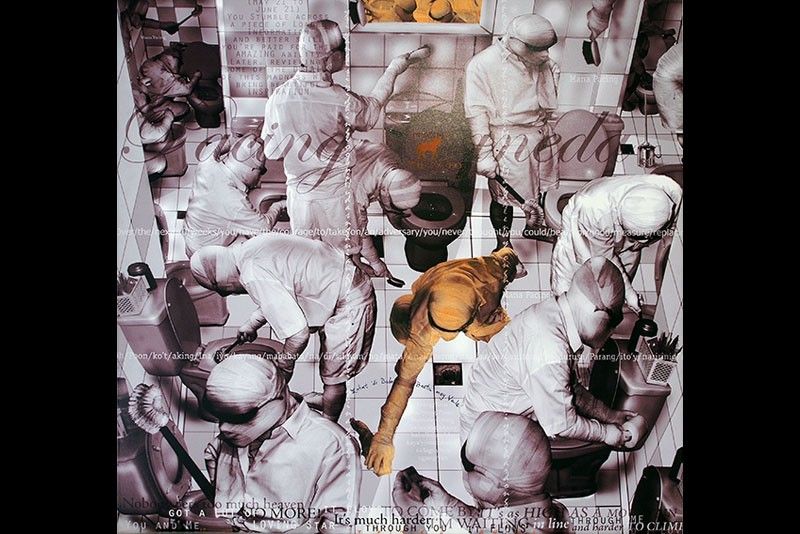The price of art: Art Stage Singapore as more than a marketplace

Bathed in the fluorescent afterglow of the Marina Bay Sands Expo, Art Stage Singapore, now in its seventh edition this year, presented yet another strong exhibition, with 131 participating art galleries from 27 countries.
It is good to note that there was a strong presence of talent from our own shores as well: including Mark Justiniani’s illusion of endless glass and mirror, which was the special exhibit that stood before the entrance of the VIP lounge; Martha Atienza’s videography of life on the sea was featured in the Collector’s Gallery, as was Kawayan De Guia’s sculpture of a horse built from old film tapes and cinema reels. Jose Tence Ruiz’s massive artwork of acrylic on canvas made a statement about how we view hard-labor workers — this was a part of the Southeast Asian exhibition; as was the work of Leslie De Chavez, whose chain whip was tipped with what looked like the late dictator Ferdinand Marcos’ head — this lay sprawled out on the floor, a real eye catcher. Meanwhile, the space was filled with the energy of students, young urbanites and collectors.
But this year, Art Stage did not only present itself as a regional art market, but also aimed to push for more conversation about art, by staging the Southeast Asia Forum. Here, they provided a venue for the exchange of ideas critical to understanding the economic and socio-political issues surrounding art today. Various talks were organized as a means to open discourse about the line between art and capitalism, asking us to reevaluate: do we view art merely as an investment, or as a cultural statement?
The founder and president of Art Stage Singapore, Lorenzo Rudolf, said it best: “We have to realize that we are living in dramatically changing times. The world economy is in crisis, politics is in crisis, society is in crisis, and all this is clearly affecting the art market. This means we can no longer sell art based only on price. We have to be clear that art can no longer be seen as mere merchandise or commodity. We have to look at art for what it really is. In essence, it is a piece of culture. Everyone in the art market — art dealers, galleries, even the artists and especially the art fair — will need to reflect on what that means for them. They have to react and go in new directions and cannot continue as they did in the past. For Art Stage Singapore, it means very clearly that we have to focus even more on content and to show art in context.”
Southeast Asia Forum
In order to spark conversation about the role and meaning of art today, the Southeast Asian Forum exhibition and lecture series, which was launched last year, was set up again this year. And in this year’s Southeast Asia Forum, they examine the art market, trying to find the balance between art, commerce and content. Its theme focuses on the overriding ideology of capitalism, titled “Net Present Value: Art, Capital, Futures.”
The forum brought together speakers from the art community and the social sciences to examine, through different perspectives, challenges relating to cultures of financialization and their impact on how we consider art and capital. These lectures allowed critics, actors and influencers to discuss issues relating to the economics of art.
The Forum also featured an exhibition with 24 artworks from various socially engaged artists that hoped to emphasize the importance of cultivating other forms of capital and conditions for the evolution of societies. Included in this exhibition was the work of local Filipino artists Norberto Roldan and Jose Tence Ruiz; Thailand’s Anon Pairot with his fabricated toy gun installation; and performance artist Carlos Celdran, who did a run of his show Livin’ La Vida Imelda.
The Collectors’ Stage
Meanwhile, also present in the fair was the Collectors’ Stage, which featured the private collections of some Singapore-based collectors. Six participating collectors lent their artworks to the fair, in order to reflect the openness and inter-connectivity of Singapore. The exhibition fostered an understanding about art collections and revealed the thought processes and motivations behind cultivating a coherent personal collection. With the Collector’s Stage, we saw that it was not just about the process of accumulating pieces — but about a dedication to bring artworks in dialogue with each other, allowing each collection to find its own way and its own character.
What is fantastic to note also in the Collectors’ Stage is that there was a strong presence of Philippine art still, further establishing our artists’ presence in Asia — a statement that emphasizes that not only does our art have value monetarily; but also that there is an understanding and deep appreciation for it within our culture, as many of these works are imbued with meaning, and representative of our cultural times.
This year, Art Stage Singapore truly shakes us by forcing us to think about the path of where art is headed, what its place is in the world, and where we should position ourselves in relation to these realities.



















